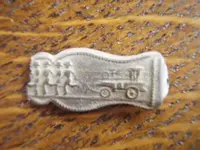tigerbeetle
Full Member
- Joined
- Jan 2, 2009
- Messages
- 166
- Reaction score
- 275
- Golden Thread
- 0
- Location
- Jersey Shore
- Detector(s) used
- Many -- Fisher, White's, Minelab, Cobra, others
- Primary Interest:
- Metal Detecting
Added comment: I believe this latest button predates the Scoville types. In fact, based on the coins in the area of both buttons, I might even place this type in the 1800 to 1810 realm. It might also be unlisted in the likes of "The Big Book of Buttons," where the later variety is pictured.
In 1980, I found a gorgeous "Fire" button. The one-piece button hales from the Federal Period. It is considered by many to be the holy grail of fire fighter buttons. With that 1980 find, I figured I had scored a once-a-lifetime rarity and refused a goodly number of offers to buy it. Then, fire struck a second time, this past weekend.
I was having a lousy day deep in the South Jersey Pinelands "outback." I couldn't detect so much as a pewter button -- a common find in the particular area I was working. I was also being choked to the hacking point by the most horrendous pine pollen layer I've seen in 50 years of Pinelands exploration. It’s so thick it swirls up like smoke when disturbed by a swinging detector.
As if pollen wasn't enough, I was under attack from a hatch of spring mosquitoes of near biblical proportions -- aided by the wettest early spring the area has ever recorded. Abandoning the hunt, I began one of those low-grade wide-swinging semi-hunts, as I speedily headed back to my truck.
As I got back toward modernity, I took an easily-heard reading. I gave it little merit since I had moved into a fully trashed out near-road zone. Still, I went through that process of kicking away surface dirt with my boot. The ground was loose. I could foot away a solid three inches of leaf litter and sugar sand. The solid “good” reading persisted, a very good sign; so good, I went into the kneeling mode. I save that genuflection method for high-percentage extractions.
Using my fierce Japanese digging tool, I made short order of some arrogant roots from green briers and nearby sassafras. The reading was even further down – and now high in the red alert zone. My hole dig went wider, as I’m inclined to do when there’s chance of slicing into a coin.
Loosening the soil to a solid ten inches down, I hand shoveled out the entire load of loosened sand. From my knees, I did a re-swing with my Fisher CZ-3D detector. The object was out of the hole and close to the surface of the piled up sand. I fingered the sand and uncovered what my overly optimistic eyes tooto be a large cent. Grabbing it, I felt the curvature and quickly saw the button loop.
Letdowness leaked in – until I turned the find over. I swear it was like seeing a family member. Not only was it a twin to my first “Fire” button but it was in identically incredible shape. I swear it was more fun the second time around.
While the find wasn’t up there with an AU 1794, it is such a look into the past, via the antiquated image on the button.
In 1980, I found a gorgeous "Fire" button. The one-piece button hales from the Federal Period. It is considered by many to be the holy grail of fire fighter buttons. With that 1980 find, I figured I had scored a once-a-lifetime rarity and refused a goodly number of offers to buy it. Then, fire struck a second time, this past weekend.
I was having a lousy day deep in the South Jersey Pinelands "outback." I couldn't detect so much as a pewter button -- a common find in the particular area I was working. I was also being choked to the hacking point by the most horrendous pine pollen layer I've seen in 50 years of Pinelands exploration. It’s so thick it swirls up like smoke when disturbed by a swinging detector.
As if pollen wasn't enough, I was under attack from a hatch of spring mosquitoes of near biblical proportions -- aided by the wettest early spring the area has ever recorded. Abandoning the hunt, I began one of those low-grade wide-swinging semi-hunts, as I speedily headed back to my truck.
As I got back toward modernity, I took an easily-heard reading. I gave it little merit since I had moved into a fully trashed out near-road zone. Still, I went through that process of kicking away surface dirt with my boot. The ground was loose. I could foot away a solid three inches of leaf litter and sugar sand. The solid “good” reading persisted, a very good sign; so good, I went into the kneeling mode. I save that genuflection method for high-percentage extractions.
Using my fierce Japanese digging tool, I made short order of some arrogant roots from green briers and nearby sassafras. The reading was even further down – and now high in the red alert zone. My hole dig went wider, as I’m inclined to do when there’s chance of slicing into a coin.
Loosening the soil to a solid ten inches down, I hand shoveled out the entire load of loosened sand. From my knees, I did a re-swing with my Fisher CZ-3D detector. The object was out of the hole and close to the surface of the piled up sand. I fingered the sand and uncovered what my overly optimistic eyes tooto be a large cent. Grabbing it, I felt the curvature and quickly saw the button loop.
Letdowness leaked in – until I turned the find over. I swear it was like seeing a family member. Not only was it a twin to my first “Fire” button but it was in identically incredible shape. I swear it was more fun the second time around.
While the find wasn’t up there with an AU 1794, it is such a look into the past, via the antiquated image on the button.
Attachments
Upvote
0

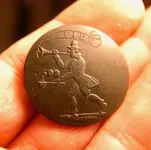
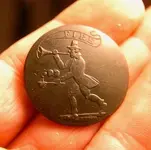
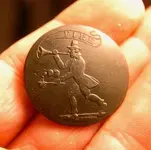
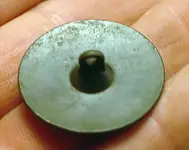
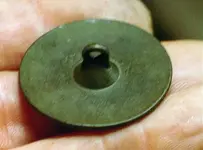
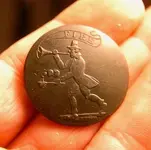
 I'll give ya a nod for "banner"....
I'll give ya a nod for "banner".... 



